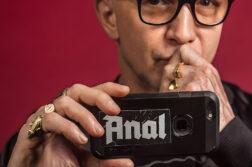By all rights, British artist Duncan Grant (1885–1978) should need no introduction. At the height of his career in the 1930’s, he was known worldwide, and his art was collected by the major museums within, as well as by many of those outside, the British Empire. Following World War II, however, his work fell into critical disfavor, and his artistic reputation has only been partly resuscitated even today.
Grant was not just an artist, he was a gay artist who lived a highly unconventional life in an era not known for its friendliness toward gay people.
He felt constrained during his lifetime to keep his homoerotic art—consisting of drawings in pen, pencil, charcoal, and watercolor, along with a few paintings in oil—private. The result: a body of work even less well known these days than his paintings of more conventional subject matter like dukes, duchesses, and English country landscapes.
It is therefore especially exciting that Grant’s homoerotic art is having its own exclusive public exhibition at New York City’s Leslie-Lohman Gay Art Foundation, November 7–December 16, 2006, in a show titled Ivory & Ebony. The pieces in the show come from the collection of Douglas Blair Turnbaugh, a New York-based collector known for his work with the unesco cultural section, who was a producer of the 2005 film Ballets Russes. Turnbaugh knew Duncan Grant personally and has published two books about him: the biography Duncan Grant and the Bloomsbury Group (Lyle Stuart, 1987), and Private: The Erotic Art of Duncan Grant (Gay Men’s Press, 1989). In the following interview, he comments on the show and on Duncan Grant the man and the artist. — Lester Strong
Lester Strong: Why is the exhibition is titled Ivory & Ebony?
Douglas Blair Turnbaugh: This will be the first show devoted exclusively to Duncan Grant’s homoerotic art that features white and black men together. It has no racial or socio-political implications. Grant was a colorist, sometimes called “the Matisse of England,” and the colors he used in these drawings weren’t just black and white, but the umbers, siennas, ochres, and crimsons to be found in his palette. He was also an out gay man and loved the male figure. The drawings show an intense erotic sensuality, revealed through Grant’s voluptuous lines and colors, as one color tops another in interplays that explore the complexities of male bodies intertwined in gay lovemaking. The words “ivory” and “ebony” are used in the title to suggest the artistic nature of the drawings, which are not pornography aimed at sexual titillation.
LS: What do you want the show to accomplish?
DBT: I want it to introduce Duncan Grant to a new generation of art lovers, and especially to a new generation of gay art lovers. His erotic work isn’t well known. But he is a role model as a gay man in both his art and his life.

LS: Could you talk about his life?
DBT: Duncan was part of the Bloomsbury group of British writers, thinkers, and artists, which included people like writers Virginia Woolf and Lytton Strachey, critic Roger Fry, economist John Maynard Keynes, and painter Vanessa Bell [Virginia Woolf’s sister], among others. The members of Bloomsbury were known for their free-love lifestyle, and were cultural trend-setters from about 1910 to World War II.
Duncan was one of the freest. He had male lovers throughout his life, and he also formed a deep emotional and artistic relationship with Vanessa Bell lasting for nearly fifty years until her death in 1961. As far as anyone knows, they had sex only once, toward the end of World War I, which produced a daughter, named Angelica. Clive Bell, Vanessa’s husband, agreeably called the baby his own, and it wasn’t until Angelica was a teenager that she learned her real father was Duncan.
As an artist, Duncan was a seminal figure in 20th-century British art. He was influenced by the work of Continental artists of various eras like Piero della Francesca, Cézanne, and Picasso. Early in his career, he was a leader in the British avant-garde and created some of the first non-objective, non-figurative, abstract, and even kinetic art in Britain. During the first part of the 20th century, the British still controlled a worldwide empire on which “the sun never set.” By the late 1930’s, Duncan was the most famous artist in that empire, and his work was collected by all the museums that were part of it, from England to Australia, South Africa, and Canada, as well as the U.S.
However, as Lord Clark [Kenneth Clark, familiar to many through his TV series Civilisation] said in his eulogy at Duncan’s funeral in 1978: “no one who loved life and visual experience as much as Duncan did could have remained an abstract painter for long, and very soon, flowers began to appear on his canvases, and seductive nudes in pastel on large sheets of paper.” By the end of World War II, when abstraction was in vogue, Duncan had moved in a figurative direction with his art, and so his artistic reputation went into eclipse for many decades.
LS: The pieces in the show are from your own collection. How did you come to own them?
DBT: I met Duncan in the early 1970’s, at the low point of his career. He still had patrons, like the Queen Mother and the Duke and Duchess of Devonshire. But hardly anyone in the larger world knew he was still painting. I wasn’t the only one who presumed he was dead. Nevertheless, he was very much alive, and still painting. He’d never cared about money or fashion, and led a pleasant life at Charleston, his English country house, with a studio in London and annual trips abroad. He had many friends.
Above all, he had Paul Roche, a man he met in 1946. Paul later married and had four children, but remained Duncan’s much loved model and companion. Duncan died in Paul’s arms in 1978. Paul himself didn’t want to write a biography of Duncan, but generously shared with me his memories of Duncan and his insights into Duncan’s character and achievements when I was writing my own biography of Duncan.
Once Duncan and I knew each other, he intuited my interest in erotica. One day he gave me the key to his studio in London and told me to look under the bed. He said: “You’ll find what you’re looking for.” There I did indeed find a cache of stunning homoerotic drawings. These were of course illicit. I told Duncan they were fabulous artworks that should be published. He laughed and said, “That can never happen!” He justifiably feared they would be destroyed after his death, and he knew I would do my best to preserve them. That’s why he gave them to me, and I did indeed publish them in my 1989 book Private: The Erotic Art of Duncan Grant. Unfortunately, Duncan didn’t live to see them published, but I’m positive he would have been very happy to know that we can see them now.
LS: What do you think Duncan Grant’s art has to say to a gay audience?
DBT: Duncan’s homoerotic art has a great deal to say. It distills his unusually guilt-free experience of gay love, which he commemorates in these glorious images. Like David Hockney, who is his direct artistic descendant in this respect, Duncan was out in his art. His motto was: “Never be ashamed.” He never was. In a contemporary world of AIDS and political and religious gay-bashing carried out by homophobic bigots in the name of God and country, it seems to me his homoerotic art offers a guiding light, especially for young gay people.
For more on Ivory and Ebony, visit the Leslie-Lohman website www.leslielohman.org.
Lester Strong, a freelance writer based in New York, is a frequent contributor to this journal.




